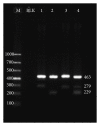A multiplex snapback primer system for the enrichment and detection of JAK2 V617F and MPL W515L/K mutations in Philadelphia-negative myeloproliferative neoplasms
- PMID: 24729973
- PMCID: PMC3960525
- DOI: 10.1155/2014/458457
A multiplex snapback primer system for the enrichment and detection of JAK2 V617F and MPL W515L/K mutations in Philadelphia-negative myeloproliferative neoplasms
Abstract
A multiplex snapback primer system was developed for the simultaneous detection of JAK2 V617F and MPL W515L/K mutations in Philadelphia chromosome- (Ph-) negative myeloproliferative neoplasms (MPNs). The multiplex system comprises two snapback versus limiting primer sets for JAK2 and MPL mutation enrichment and detection, respectively. Linear-After exponential (LATE) PCR strategy was employed for the primer design to maximize the amplification efficiency of the system. Low ionic strength buffer and rapid PCR protocol allowed for selective amplification of the mutant alleles. Amplification products were analyzed by melting curve analysis for mutation identification. The multiplex system archived 0.1% mutation load sensitivity and <5% coefficient of variation inter-/intra-assay reproducibility. 120 clinical samples were tested by the multiplex snapback primer assay, and verified with amplification refractory system (ARMS), quantitative PCR (qPCR) and Sanger sequencing method. The multiplex system, with a favored versatility, provided the molecular diagnosis of Ph-negative MPNs with a suitable implement and simplified the genetic test process.
Figures






References
-
- Vannucchi AM, Guglielmelli P, Tefferi A. Advances in understanding and management of myeloproliferative neoplasms. CA Cancer Journal for Clinicians. 2009;59(3):171–191. - PubMed
-
- Levine RL, Wadleigh M, Cools J, et al. Activating mutation in the tyrosine kinase JAK2 in polycythemia vera, essential thrombocythemia, and myeloid metaplasia with myelofibrosis. Cancer Cell. 2005;7(4):387–397. - PubMed
-
- Baxter EJ, Scott LM, Campbell PJ, et al. Acquired mutation of the tyrosine kinase JAK2 in human myeloproliferative disorders. The Lancet. 2005;365:1054–1061. - PubMed
-
- Jones AV, Kreil S, Zoi K, et al. Widespread occurrence of the JAK2 V617F mutation in chronic myeloproliferative disorders. Blood. 2005;106(6):2162–2168. - PubMed
-
- Kralovics R, Passamonti F, Buser AS, et al. A gain-of-function mutation of JAK2 in myeloproliferative disorders. The New England Journal of Medicine. 2005;352(17):1779–1790. - PubMed
Publication types
MeSH terms
Substances
LinkOut - more resources
Full Text Sources
Other Literature Sources
Medical
Miscellaneous

